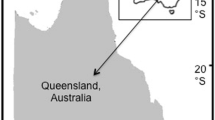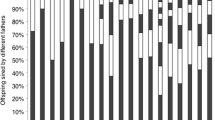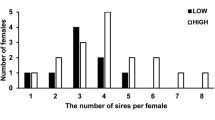Abstract
To resolve conflicting field observations regarding the action of sexual selection, we used breeding experiments and paternity analysis of the 927 resulting offspring to assess how male size, condition, tail length, genetic similarity to the female, and variation in operational sex ratio (OSR) affected male reproductive success and the incidence of polyandry in northern watersnakes (Nerodia sipedon). Only size affected male mating success. Large males were more successful, but only when male size varied substantially and competition among males was intense (i.e., male-biased OSR). The conditional nature of the size advantage may explain why studies of free-living watersnakes have produced inconsistent results regarding the relationship between male size and mating success. Size differences between males did not affect the proportion of offspring each male sired within multiply sired litters. We found positive size-assortative mating, but only when the OSR was female biased, suggesting that smaller males had improved access to females when competition among males was reduced, but that competition with larger males still restricted mating opportunities of small males to less preferred, smaller females. Most litters (58%) were multiply sired and larger females were more likely to produce multiply sired litters, similar to free-living watersnakes. There was no association between the incidence of multiple paternity and OSR, however, suggesting that polyandry is not simply a function of opportunity, with females passively waiting for males to court them.




Similar content being viewed by others
References
Barry FE, Weatherhead PJ, Philipp DP (1992) Multiple paternity in a wild population of northern water snakes, Nerodia sipedon. Behav Ecol Sociobiol 30:193–199
Blouin-Demers G, Gibbs HL, Weatherhead PJ (2005) Genetic evidence for sexual selection in black ratsnakes (Elaphe obsoleta). Anim Behav 69:225–234
Blouin-Demers G, Weatherhead PJ (2002) Implications of movement patterns for gene flow in black rat snakes (Elaphe obsoleta). Can J Zool 80:1162–1172
Brown GP, Weatherhead PJ (1999) Female distribution affects mate searching and sexual selection in male northern water snakes (Nerodia sipedon). Behav Ecol Sociobiol 47:9–16
Brown GP, Weatherhead PJ (2000) Thermal ecology and sexual size dimorphism in northern water snakes, Nerodia sipedon. Ecol Monogr 70:311–330
Brown GP, Weatherhead PJ (2004) Sexual abstinence and the cost of reproduction in adult male watersnakes, Nerodia sipedon. Oikos 104:269–276
Cooper WE Jr, Vitt LJ (1997) Maximizing male reproductive success in the broad-headed skink (Eumeces laticeps): preliminary evidence for mate guarding, size assortative paiting, and opportunistic extra-pair mating. Amphibia-Reptilia 18:59–73
Emlen ST, Oring LW (1977) Ecology, sexual selection, and the evolution of animal mating systems. Science 197:215–223
Gibbs HL, Weatherhead PJ (2001) Insights into population ecology and sexual selection in snakes through the application of DNA-based genetic markers. J Hered 92:173–179
Gibson AR, Falls JB (1975) Evidence for multiple insemination in the common garter snake, Thamnophis sirtalis. Can J Zool 53:1362–1368
Goodnight KL, Quellar DC (1999) Computer software for performing likelihood tests of pedigree relationship using genetic markers. Mol Ecol 8:1231–1234
Gregory PT (1974) Patterns of spring emergence of the red-sided garter snakes (Thamnophis sirtalis parietalis) in the Interlake of Manitoba. Can J Zool 53:238–245
Hosmer DW, Lemeshow S (2000) Applied logistic regression, 2nd edn. Wiley, New York
Iman RL, Conover WJ (1979) The use of the rank transform in regression. Technometrics 21:499–509
Jennions MD, Petrie M (2000) Why do females mate multiply? A review of the genetic benefits. Biol Rev 74:21–64
Joy JE, Crews D (1988) Male mating success in red-sided garter snakes: size is not important. Anim Behav 36:1839–1841
Kissner KJ, Weatherhead PJ (2005) Phenotypic effects on survival of neonatal northern watersnakes. J Anim Ecol 74:259–265
Lombardo MP (1998) On the evolution of sexually transmitted diseases in birds. J Av Biol 29:314–321
Lombardo MP (2000) Microbes in tree swallow semen. J Wildl Dis 36:460–468
Madsen T, Shine R (1992) Temporal variability in sexual selection acting on reproductive tactics and body size in snakes. Am Nat 141:167–171
Madsen T, Shine R, Loman J, Hakansson T (1992) Why do female adders copulate so frequently? Nature 355:440–441
Madsen T, Shine R, Loman J, Hakansson T (1993) Determinants of mating success in male adders, Vipera berus. Anim Behav 45:491–499
Mason RT, Crews D (1985) Female mimicry in garter snakes. Nature 316:59–60
Olsson M (1993) Male preference for large females and assortative mating for body size in the sand lizard (Lacerta agilis). Behav Ecol Sociobiol 32:337–341
Olsson M, Madsen T, Shine R, Gullberg A, Tegelström H (1994) Rewards of promiscuity. Nature 372:230
Olsson M, Shine R, Gullberg A, Madsen T, Tegelström H (1996) Sperm selection by females. Nature 383:585
Prosser MR (1999) Sexual selection in northern water snakes, Nerodia sipedon sipedo. PhD thesis, McMaster University, Hamilton, ON
Prosser MR, Gibbs HL, Weatherhead PJ (1999) Microgeographic population genetic structure in the northern water snake, Nerodia sipedon sipedon, detected using microsatellite DNA loci. Mol Ecol 8:329–333
Prosser MR, Weatherhead PJ, Gibbs HL, Brown GP (2002) Genetic analysis of the mating system and opportunity for sexual selection in northern water snakes (Nerodia sipedon). Behav Ecol 13:800–807
Queller DC, Goodnight KF (1989) Estimating relatedness using genetic markers. Evolution 43:258–275
SAS (1999) SAS user's guide: statistics, Version, 8th edn. Statistical Analysis Systems, Cary, North Carolina
Schwartz JM, McCracken GF, Burghardt GM (1989) Multiple paternity in wild populations of the garter snake, Thamnophis sirtalis. Behav Ecol Sociobiol 25:269–273
Seutin G, White BN, Boag PT (1991) Preservation of avian blood and tissue samples for DNA analysis. Can J Zool 69:82–90
Shine R (1993) Sexual dimorphism in snakes. In: Seigel RA, Collins JT (eds) Snakes: ecology and behavior. McGraw-Hill, New York, pp 49–86
Shine R, Bonnet X (2000) Snakes: a new “model organism” in ecological research? TREE 15:221–222
Shine R, Olsson MM, Moore IT, LeMaster MP, Mason RT (1999) Why do male snakes have longer tails than females? Proc R Soc Lond B 266:2147–2151
Shine R, Olsson MM, Moore IT, LeMaster MP, Greene M, Mason RT (2000) Body size enhances mating success in male garter snakes. Anim Behav 59:F4–F11
Shine R, O'Connor D, LeMaster MP, Mason RT (2001) Pick on someone your own size: ontogenetic shifts in mate choice by male garter snakes result in size-assortative mating. Anim Behav 61:1133–1141
Stille B, Madsen T, Niklasson M (1986) Multiple paternity in the adder, Vipera berus. Oikos 47:173–175
Weatherhead PJ, Barry FE, Brown GP, Forbes MRL (1995) Sex ratios, mating behavior and sexual size dimorphism of the northern water snake, Nerodia sipedon. Behav Ecol Sociobiol 36:301–311
Weatherhead PJ, Brown GP, Prosser MR, Kissner KJ (1998) Variation in offspring sex ratios in the northern water snake (Nerodia sipedon). Can J Zool 76:2200–2206
Weatherhead PJ, Prosser MR, Gibbs HL, Brown GP (2002) Male reproductive success and sexual selection in northern water snakes determined by microsatellite DNA analysis. Behav Ecol 13:808–815
Westneat DF, Rambo TB (2000) Copulation exposes female red-winged blackbirds to bacteria in male semen. J Av Biol 31:1–7
Acknowledgements
We thank G. Blouin-Demers, G. Brown, E. O'Grady, M. Prosser, C. Verrault, F. Phelan, F. Connor, R. Green, S. Sommerer, J. Gilchrist, D. Bender, K. Metz, J. Svec, H. McCracken, T. Volk, A. Moenting, C. Yourth, P. Begin, S. Doucet and J. Jones for help constructing the enclosures and/or help in the field. We thank L. DeSousa, B. Woolfenden, M. Kasumovic and L. Blanchard for help in the laboratory and G. Brown and D. Bender for providing statistical advice. Financial support was provided by the Natural Sciences and Engineering Research Council of Canada, the province of Ontario, Carleton University, McMaster University and the University of Illinois
Author information
Authors and Affiliations
Corresponding author
Additional information
Communicated by W. Cooper
Rights and permissions
About this article
Cite this article
Kissner, K.J., Weatherhead, P.J. & Gibbs, H.L. Experimental assessment of ecological and phenotypic factors affecting male mating success and polyandry in northern watersnakes, Nerodia sipedon . Behav Ecol Sociobiol 59, 207–214 (2005). https://doi.org/10.1007/s00265-005-0026-7
Received:
Revised:
Accepted:
Published:
Issue Date:
DOI: https://doi.org/10.1007/s00265-005-0026-7




